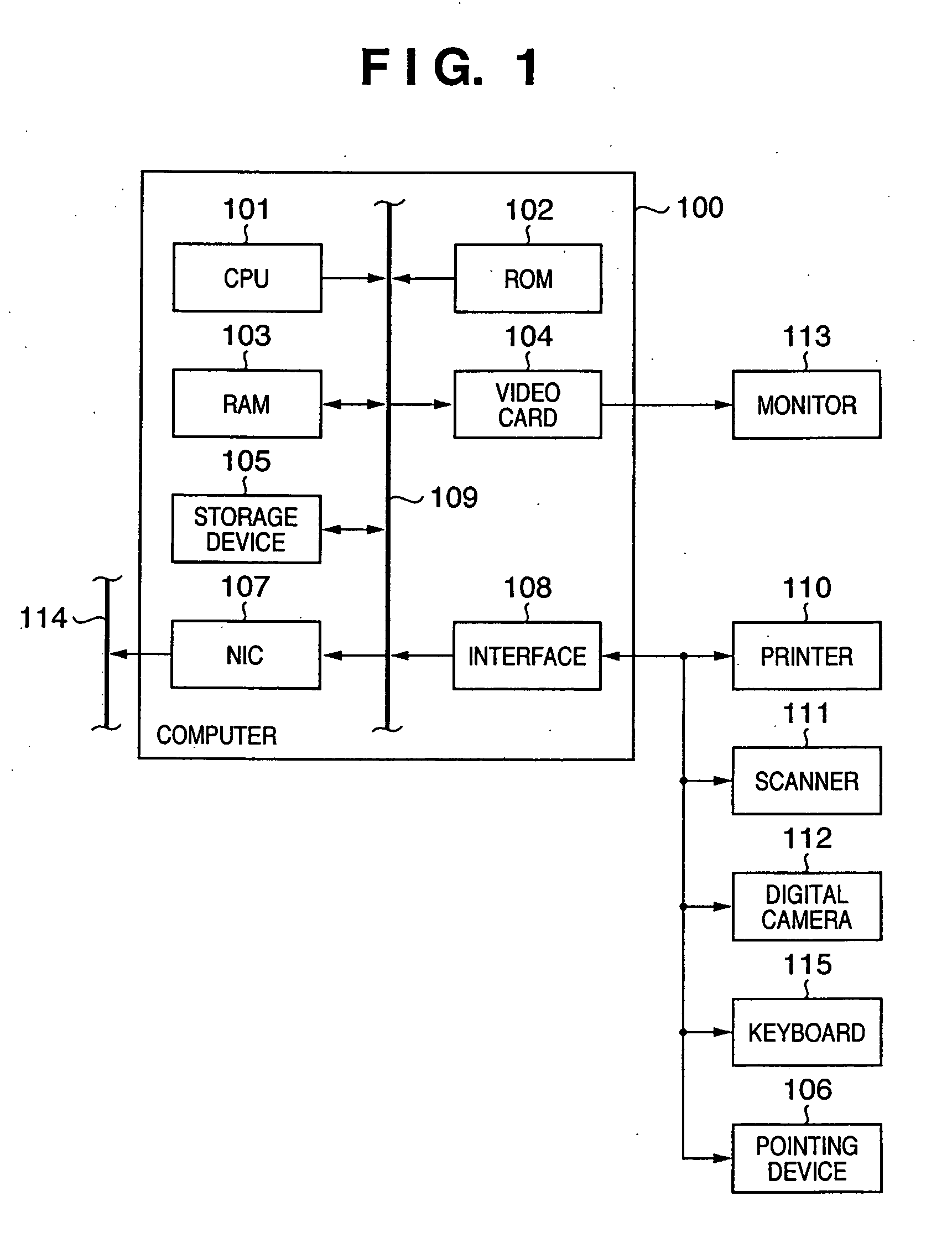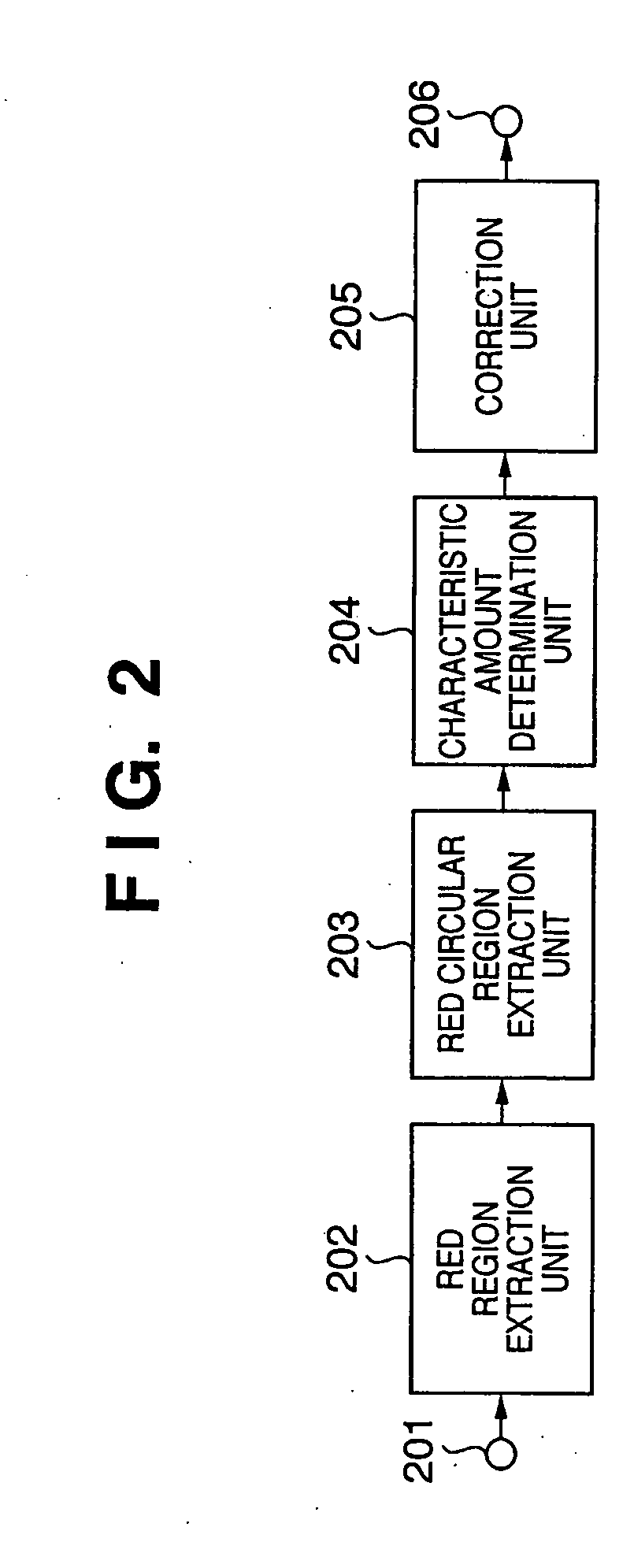Image processing apparatus and method, computer program, and storage medium
- Summary
- Abstract
- Description
- Claims
- Application Information
AI Technical Summary
Benefits of technology
Problems solved by technology
Method used
Image
Examples
first embodiment
[Arrangement of Apparatus]
[0069]FIG. 1 is a block diagram showing the arrangement of a computer (image processing apparatus) which executes image processing of the first embodiment.
[0070] A computer 100 comprises a CPU 101, a ROM 102, a RAM 103, a video card 104 which connects a monitor 113 (which may comprise a touch panel), and a storage device 105 such as a hard disk drive, memory card, and the like. Also, the computer 100 comprises an interface 108 for a serial bus such as USB, IEEE1394, or the like, which connects a pointing device 106 such as a mouse, stylus, tablet, or the like, a keyboard 107, and the like. Furthermore, the computer 100 comprises a network interface card (NIC) 107 which connects a network 114. These components are interconnected via a system bus 109. A printer 110, scanner 111, digital camera 112, and the like can be connected to the interface 108.
[0071] The CPU 101 loads programs (including a program of image processing to be described below) stored in t...
second embodiment
[0199] Image processing according to the second embodiment of the present invention will be described below. Note that the same reference numerals in the second embodiment denote the same parts as in the first embodiment, and a detailed description thereof will be omitted.
[0200] The adaptive binarization processing described in the first embodiment sets the window 403 (see FIG. 4) having a predetermined size in the left direction (front side of the main scan direction) of the interest pixel. The average value Er(ave) of the evaluation values of pixels in the window 403 is calculated, and whether or not the interest pixel forms a red color region is checked using the average value Er(ave) as a threshold, thus attaining binarization. Such method refers to a small number of pixels to calculate the threshold, and can speed up the processing. However, since the window 403 is set in only the left direction of the interest pixel, the binarization result depends on the processing direction...
third embodiment
[0210] Image processing according to the third embodiment of the present invention will be described hereinafter. Note that the same reference numerals in the third embodiment denote the same parts as in the first and second embodiments, and a detailed description thereof will be omitted.
[0211] In the first and second embodiments, the method for extracting pixels which form a red color region by executing the adaptive binarization processing that focuses attention on the evaluation value Er given by equation (3) has been described. Such method often detects pixels of an inner or outer canthus portion 2202 as pixels which form a red color region in addition to a pupil portion 2201 of a red-eye image. When the inner or outer canthus portion 2202 is enlarged, many “dark red” pixels specified by, e.g., (R, G, B)=(81, 41, 31) exist. The evaluation value of this pixel is 49%, i.e., a relatively large value. For this reason, in the adaptive binarization processing of the first and second ...
PUM
 Login to View More
Login to View More Abstract
Description
Claims
Application Information
 Login to View More
Login to View More - R&D
- Intellectual Property
- Life Sciences
- Materials
- Tech Scout
- Unparalleled Data Quality
- Higher Quality Content
- 60% Fewer Hallucinations
Browse by: Latest US Patents, China's latest patents, Technical Efficacy Thesaurus, Application Domain, Technology Topic, Popular Technical Reports.
© 2025 PatSnap. All rights reserved.Legal|Privacy policy|Modern Slavery Act Transparency Statement|Sitemap|About US| Contact US: help@patsnap.com



